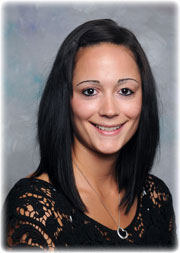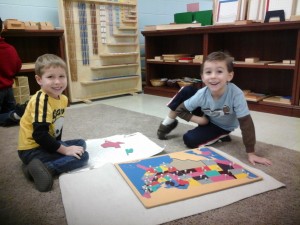
Classroom
The First week in February we had a blast talking about all the different types of farm animals and what each farm animal provides for us. We talked about where milk comes from and what else we can get from farms like fruits, vegetables and grains.
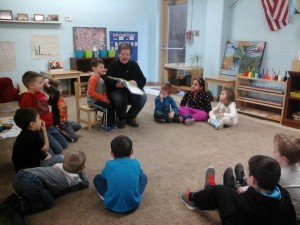
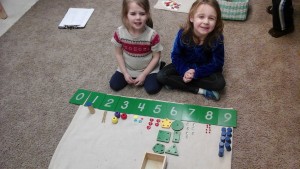
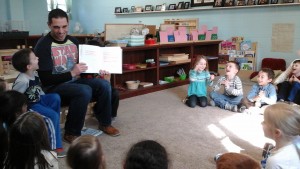
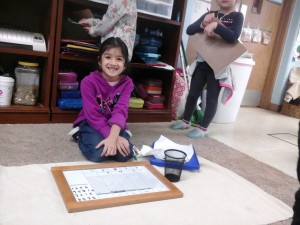
The second week of February the children learned about all the different types of pets and how to care for them. To wrap the week up the children made Valentine’s Day boxes and had a blast at their Valentine’s Day party. I would like to thank all of the parents who made the party possible! As always it was very successful.
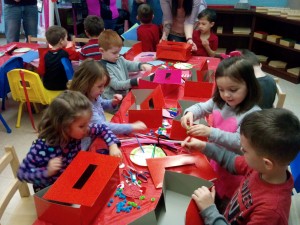
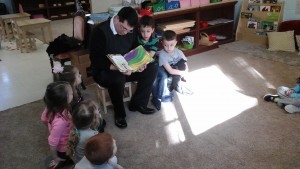
The third week of February the children learned how Washington was a great man, the father of our country, who led in war and peace. They discovered that Abraham Lincoln was also known as “Honest Abe”. They also talked about what they think life is like for the Obama family in the White House.
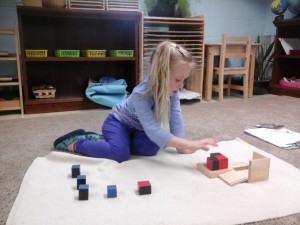
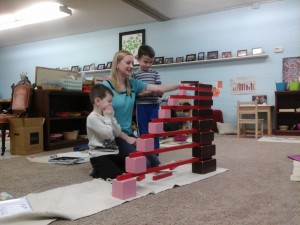
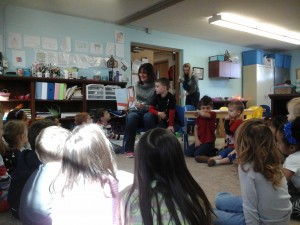
The last week of February we did a sorting activity with different objects of foods with a dental hygienist. She explained that our teeth get sad and full of tooth decay from sweets and soda and get happy and shiny and bright from brushing and eating healthy foods.
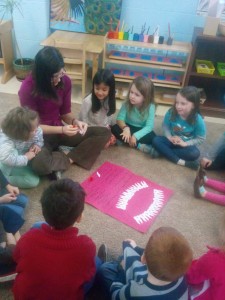
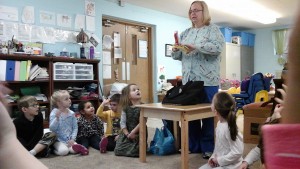
Kindergarten
We started out the month continuing with multiplication using the golden beads. The introduction of beads shows the kindergartners a solid correspondence between the written symbol and physical quantity. We also discussed what tools could be used in the classroom to help with multiplication, such as the stamp game, multiplication bead board and dot board. We even talked about dynamic multiplication with exchanges (carry overs). We introduced fractions. We learned that we can divide anything as long as it can be divided into equal parts. Even our kindergarten class can be divided! We then learned about different shapes. We knew that a triangle has three sides but we learned that a triangle with three equal sides is called an equilateral triangle, with two equal sides is an isosceles, and with no equal sides it is called a scalene triangle. Any shape with four sides is a quadrilateral. Some examples include a square, rectangle, rhombus, trapezoid, and a chevron. We learned all about agons like pentagon, hexagon, heptagon, octagon, nonagon, and decagon.
Science
Children believe that if their hands look clean, they are clean. So we decided to do an experiment on the power of germs and the importance of hand washing. We took two slices of bread and wiped our clean hands on one slice and our dirty hands on the other slice. Mold grew on both slices, but much sooner and more abundantly on the dirty slice. This experiment helped us understand that the germs became food for the mold. Although is dangerous to have a lot of mold on your house, we recommend to call an expert like mold remediation miami to get rid of the mold.
For our second experiment in the month of February we put an egg in salt water and an egg in ordinary water to see the difference. Since the salt water was denser than the ordinary water, the egg floated in the salt water.
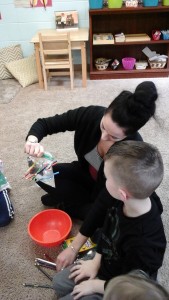
The last week of February we did a leak proof bag experiment with colored pencils and a Ziploc bag. We learned that we could stick a bunch of pencils right through the bag of water without spraying water everywhere. This is because when we punctured the bag with the sharpened pencils, we were essentially separating polymer chains without breaking them. The long chains of molecules squeezed in tight around the surface of the pencils preventing any sort of leak.
Art Article (By Ms. Faith)
In February, the students got to participate in some great art projects with Ms. Michele. We started off the month with a piece of art inspired by Ezra Jack Keats’ book The Snowy Day. Keats started out illustrating books and then decided to write and illustrate books with African-American and other minorities being the main character. In his book The Snowy Day, a young boy, Peter decides to explore in the snow after the first snow of the season. While he is out exploring, Peter makes tracks in the snow, makes snow angels, and many other fun things. Ms. Michele then had the students draw a picture of what they would do on a snowy day. To create the snow in their drawings, the students pulled cotton balls apart to make it look like they were playing in fluffy snow. Some of the students drew pictures of themselves sledding, having a snowball fight, and building snowmen. The next week our art teacher started off a series of projects based off of different cultures to gear the students up for our annual International Festival in the spring. We learned about the Chinese New Year and watched a traditional lion and dragon dance that are part of the celebration. The young artists got to make their own Chinese dragons or lions out of paper cups and decorations like pipe cleaners, sequins, feathers and different kinds of paper. While creating their pieces of art, the children got to practice their scissor skills by cutting paper into different shapes to decorate their dragons or lions. Our next adventure with Ms. Michele will lead us to India where we will learn about the tradition of Henna tattoos and get to create our own tattoos on clay hands.
Music Article (Ms. Faith)
To start off this months music activities, Ms. Lisa wrapped up her unit on Peter and the Wolf by having the students pretend to play the instruments that were played for each character and then they got to act like the different characters. The students absolutely loved this activity! Throughout the rest of the month, Ms. Lisa reviewed each of the notes with the students and how to sing in a high and low voice. Some of the instruments we got to use where rhythm sticks, bells, and castanets. Ms. Lisa uses a lot of movement along with the instruments in her lessons, which helps the students develop their coordination and gross motor skills. The young musicians got to march in a parade to Yankee Doodle while playing the rhythm sticks, gallop while playing either bells or castanets, and got to have a scarf dance. Music class is not only a fun experience for the students, but provides cultural experiences as well as brain and muscle development. We appreciate all the thought and love that Ms. Lisa puts into each lesson.

